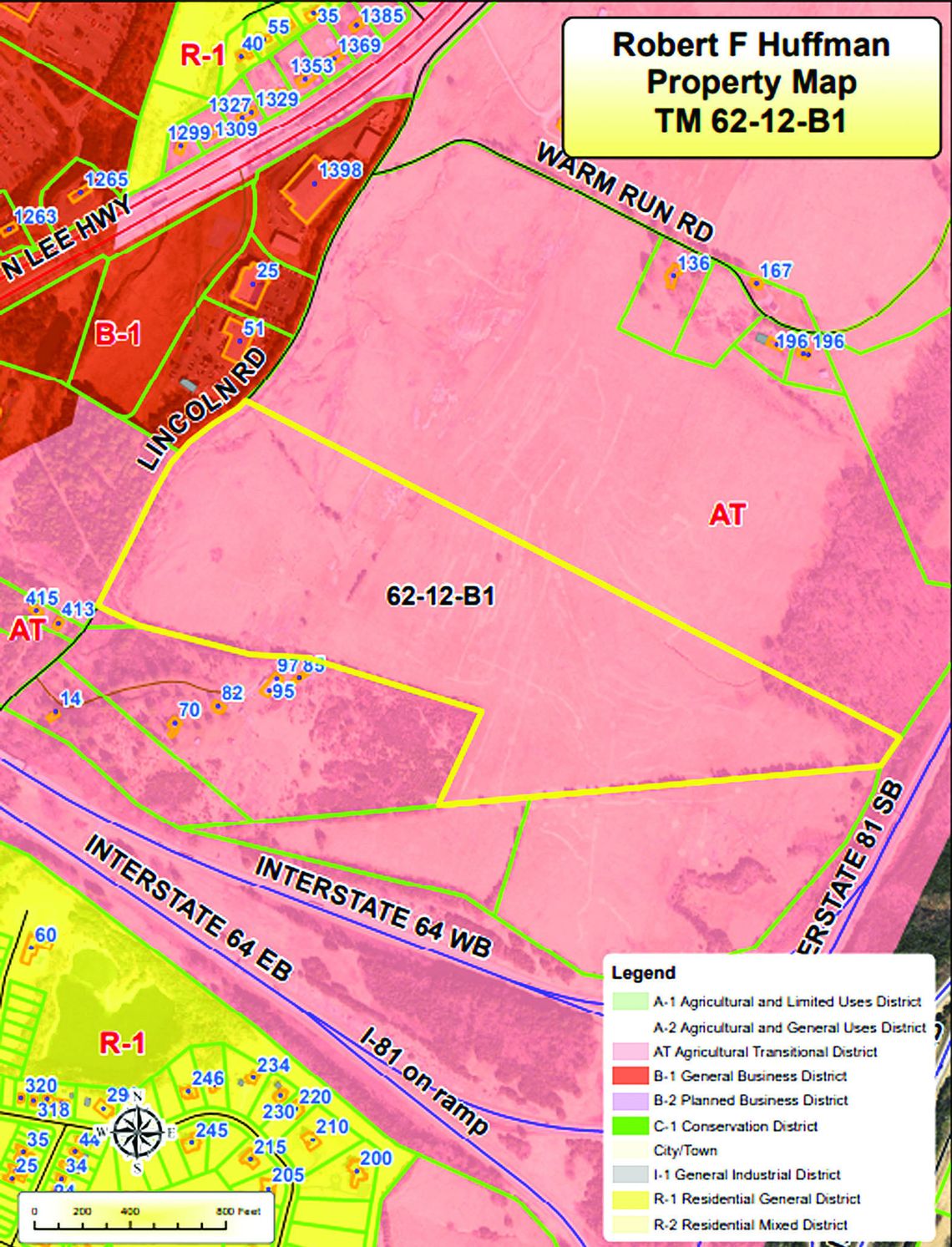Clash Over Solar
Array
Planners Delay Vote On Project
A couple of dozen speakers aired their views about the proposed Warm Run solar array at last Wednesday’s meeting of the Rockbridge County Planning Commission.
No action was taken on the application by Warm Run Solar LLC for a special exception permit, which will be an agenda item at the Commission’s next meeting on Sept. 11.
Most of the speakers at last week’s public hearing expressed opposition to the 3.0 megawatts solar facility planned for 34 acres of farmland between the Interstate 64/U.S. 11 and I-81/I-64 interchanges, east of U.S. 11 and north of Interstate 64, though several speakers contended that it would be hard to find a more suitable site for a renewable energy project of this type.
Views of the site from Interstates 64 and 81, businesses on U.S. 11 and neighboring properties will be obscured, say project officials, by the site’s comparatively lower elevation and wooded areas surrounding the site that will be enhanced by the introduction of a buffer with native plants and pollinator grasses “If you wanted to find an invisible site in Rockbridge County, this is pretty close to it,” asserted Lee Merrill, who said he’d driven all around the site and found it to be hardly visible, even from adjacent properties.
The site is part of a 56-acre tract that is itself part of 167 contiguous acres of a farm owned by Robert F. Huffman, trustee for the H. Randall Huffman land trust. The site is located on the east side of Lincoln Road (Va. 763), half-a-mile south of the intersection of Lincoln Road and N. Lee Highway (U.S. 11). The property is in the agricultural transitional (A-T) zoning district and is accessed from Warm Run Road (Va. 788).
“Most people would agree that a solar power plant is an eyesore,” said neighboring land owner Mitchell Davis. “The solar company says they’ll hide it with plants and trees. If anybody’s been there [they’d know] it’s rock on the surface. Where there is dirt, it’s very thin. I know trees aren’t going to grow there. If [the project] is allowed to go through, it will … be an eyesore. It’s not going to be hidden.”
Davis cast doubt on studies that purport to show solar plants don’t lower land values of neighboring properties. He said there are studies that show they do lower values and that “common sense” says they do. Davis said he had put his land in a conservation program that aims to “reestablish valuable land cover, improve water quality, prevent soil erosion and reduce the loss of wildlife habitat.” A solar power plant would run counter to all of this, he said, “[and is of] no benefit to the people of Rockbridge County.”
Catie Cyrus, an ecologist who resides in the Walkers Creek District, praised the project planners for proposing the use of native grasses and pollinator species in a buffer. “There are a lot of benefits,” she said. “Pollinator habitat is not only aesthetically pleasing, it also provides enhanced erosion and sediment control because of the deep-rooted systems, compared to turf and pasture. It also increases biodiversity, provides habitat for our native pollinators and fauna. The use of [a proposed] woven wire [fence] will allow small mammals and other smaller wildlife to be able to go in and out of the site.”
Cyrus said she found the project to be “responsibly well-sited” in an area the county’s Comprehensive Plan characterizes as “a predominantly commercial corridor and a prime candidate for future commercialrelated activities. That’s in reference to Route 11, I-81 and I-64. I think this project is, therefore, in line with the Comprehensive Plan [and] in an area that we’re already seeing accelerated development. The project not only fits in with the landscape but also keeps the land as agricultural transitional during the life of the project. When decommissioned, it could be returned to agricultural purposes.”
Steve Kator expressed skepticism that the site could ever go back to being farmland. “When you take farmland and put a solar array over it, you’ve made it into a de facto industrial district.” He said it’s a “myth to think that this solar project is going to power any of Rockbridge County. It’s going to enter the grid and go to wherever the demand is the greatest. The demand is greatest in the big cities, especially Northern Virginia, where they have built over 300 data centers in the last 10 years.”
He continued: “The bottom line is that utility-scale solar power is wrong for Rockbridge County. In a couple of decades, our kids are going to ask us, when they look at the mess that we’ve made, ‘What were you thinking?’ And our honest answer will be, ‘We thought we were averting an environmental catastrophe,’ but we just made it worse.”
Allen Stout, who bought a nearby house in 2021 that had been part of the Huffman land trust, said he’s spent the past two-and-a-half years “investing [in] and personalizing our scenic property,” only to be met with “a destructive assault on our home and the enjoyable, peaceful quality of life that we have worked so hard to obtain.”
What he described as a potential “invasion of a solar plant” would be a “terrible violation of Virginia’s statutory zoning ordinances and the county’s Comprehensive Plan, both established to protect the safety, health and welfare of the citizens in their private property rights. There is absolutely zero benefit collectively to the citizens of the county from this project.”
Bob Biersack, president of Rockbridge Conservation (formerly RACC), spoke of how the solar array would contribute to countering the ill effects of climate change. “We have an obligation to participate in the process of managing and mitigating the climate change that’s happening around us. We created it; we have a responsibility to try to mitigate it, and this is part of that process.”
He praised the project planners for “using native plants and pollinators” that, he said, will improve the soil. “This land, 40 years from now, will be much better off than it is today. It will be much more productive, much more useful in agriculture.” He noted that “one of the greatest threats to the rural aspects of this community over time may well be that people from the places like the tidal areas of Virginia and further south are going to need to move because the water levels are going to be higher. And where are they going to go? They’re going to come to places like this, where climate impacts are mitigated to an extent. It’s good to consider that too.”
Taking a contrary view was Kris Baumann, a former tax attorney who moved here from Washington, D.C., a few years ago. “This is all about taxes,” he declared. “And, with all due respect to my friends in the environmental community – I have supported RACC financially, I have lent my expertise to RACC – this has nothing to do with solar – this is about taxes. The Inflationary Reduction Act that passed created a credit bonanza for a billion-dollar industry.”
The LLCs who buy into these projects, he said, “will sell [them] and write off these credits as soon as it’s profitable for them. They’ll turn around in 10 years and make all their money back and still have that asset. What’s wrong with that? It means none of our conditions, none of our regulations, none of our statutes will work with this industry because they don’t care about solar.”
Baumann predicted that these projects won’t be decommissioned when the time comes and that the county won’t be able to go after those responsible because, once the projects have changed hands multiple times, “We’re not going to be able to figure out who [the projects owners] are.”
Taking the opposite view that this project was indeed about solar, a renewable energy resource that will benefit future generations, was Eric Sheffield. “I’ll have to work pretty hard to see any part of this installation, but when I do, I’ll see better energy independence for our community, steady income for the landowner and county, lower taxes and a better future for our grandchildren.
“Everyone in this room uses electricity and, chances are, will be using more in the future. We need to take some personal responsibility and not just say we want our electricity to come from somewhere else. I’m guessing that, given the option of siting coal, gas, nuclear, wind or solar in Rockbridge County, that most of us would pick solar. It’s perfectly reasonable to ask where the best locations are for placing these facilities but it’s not responsible or prudent to say we don’t need any.”
He continued: “Unlike many other kinds of development, the one good thing about solar panels is that it is a light use that can be fairly easily removed if not needed or the landowner decides on other uses on their property. Thank you for listening and I commend you in your deliberations to find the best way forward for keeping Rockbridge beautiful, respecting private property rights, keeping taxes low and securing the best future for the children of Rockbridge.”
At the conclusion of the public hearing, Tony Subrizi, saying he needed more time to study the various issues raised, made a motion to continue discussion of the proposal at the next Planning Commission meeting. Subrizi’s initial motion died for lack of a second.
Andrew Sandridge then made a motion to deny the applicant’s request for a special exception permit. The motion died on a 2-2 vote, with Sandridge and Robert Kramer supporting it while David Whitmore and Subrizi voting against it. (A fifth Commission member, Tom Beebe, was absent.)
Finally, a second motion by Subrizi to continue discussion until the next meeting on Sept. 11 prevailed on a 4-0 vote.





